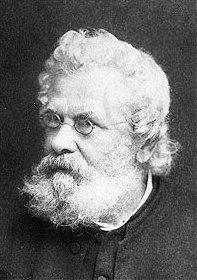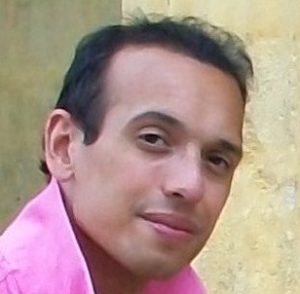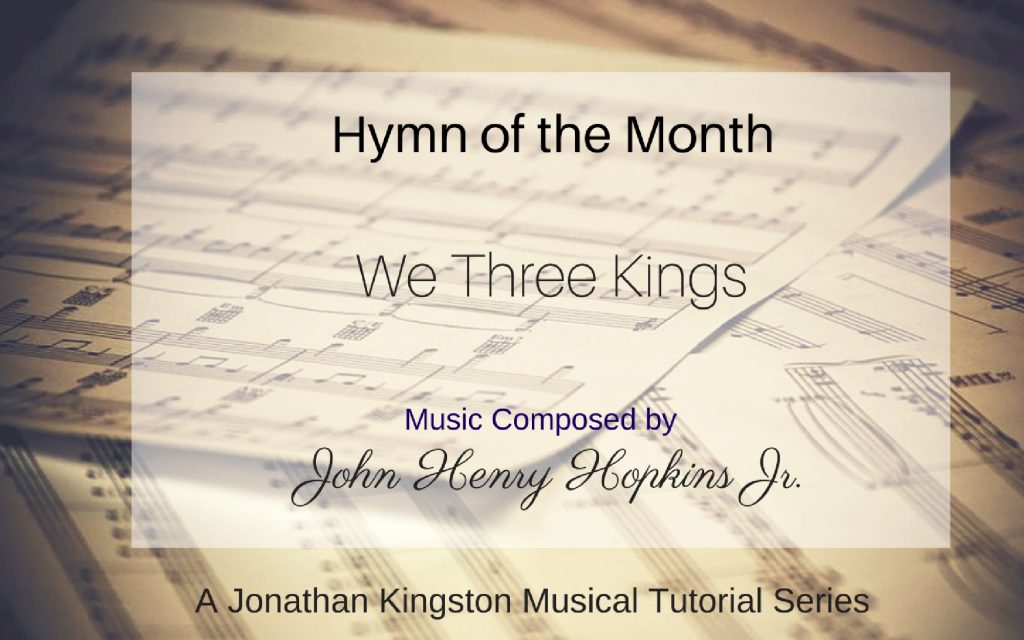The first tune of this year’s Hymn of the Month series is the famous hymn “We Three Kings”. It is also commonly known as “We Three Kings of Orient Are” or “The Quest of the Magi”, and is a Christmas carol written by John Henry Hopkins Jr. (1820 – 1891). Hopkins wrote the words and music to the hymn as part of a Christmas pageant in New York for his nieces and nephews. It is suggested to have been written in 1857 but did not appear in print until his Carols, Hymns and Songs in 1863.
Hopkins was born in Pittsburgh, Pennsylvania, the son of John Henry Hopkins, an Episcopal bishop from Dublin. Young John Henry graduated from the University of Vermont in 1839. He started his professional career working as a reporter in New York City while also studying law. However, it seemed that he soon settled on a different career path when he enrolled at General Theological Seminary in New York City. He graduated in 1850 and the very same year he was ordained a deacon. In 1853 he founded the publication Church Journal and served as its editor until 1868. It was during this period that he wrote “We Three Kings” (1857). He was ordained a priest in 1872 and later became rector of Trinity Church. He died at a friend’s home near Hudson, New York, August 14, 1891.
the son of John Henry Hopkins, an Episcopal bishop from Dublin. Young John Henry graduated from the University of Vermont in 1839. He started his professional career working as a reporter in New York City while also studying law. However, it seemed that he soon settled on a different career path when he enrolled at General Theological Seminary in New York City. He graduated in 1850 and the very same year he was ordained a deacon. In 1853 he founded the publication Church Journal and served as its editor until 1868. It was during this period that he wrote “We Three Kings” (1857). He was ordained a priest in 1872 and later became rector of Trinity Church. He died at a friend’s home near Hudson, New York, August 14, 1891.
It could be said that John Henry Hopkins Jr. was a bit of a one-hit-wonder as he is really most famous for writing this Christmas carol. However, it is worth a mention that he was a man of many talents and also wrote other carols, hymns and songs. His most important musical publication was his collection, Carols, Hymns and Songs (1863-1887). In addition to being a composer he was also a writer and poet, and edited numerous articles and books.
This hymn is most appropriate for Epiphany, and may be one of the first songs to come to mind about the story of the magi in Matthew 2. There are five stanzas and a refrain. The opening stanza is about the journey of the Magi to Bethlehem. The next three stanzas elaborate on the meaning of each of the 3 gifts, while the final stanza is a celebration that Christ has come. Many versions of this song have been composed and it remains a popular Christmas carol around the world.
This is played on a custom built Envoy 23-S, which is a very popular church instrument.
More About Jonathan Kingston’s Musical Background
 Jonathan studied the organ with Professor Ian Tracey and Ian Wells of Liverpool’s Anglican Cathedral, home to one of the largest pipe organs in the world. He was appointed Organ Scholar, and subsequently Sub-Organist to Bradford Cathedral before securing positions as Assistant Director and Director of Music at two leading independent schools. He is currently Associate Director of Music at the Ordinariate Church of Our Lady of the Assumption, Piccadilly.
Jonathan studied the organ with Professor Ian Tracey and Ian Wells of Liverpool’s Anglican Cathedral, home to one of the largest pipe organs in the world. He was appointed Organ Scholar, and subsequently Sub-Organist to Bradford Cathedral before securing positions as Assistant Director and Director of Music at two leading independent schools. He is currently Associate Director of Music at the Ordinariate Church of Our Lady of the Assumption, Piccadilly.
Jonathan’s Work With Viscount
Jonathan works with us as our very own inhouse organist – he covers several areas from sales, demonstrations, voicing of instruments and performing. His playing features on the current promotional DVD material for Viscount, and he would be very pleased to hear from any churches or individuals requiring an engaging and lively recitalist. If you would like to connect with Jonathan directly, please feel free to follow him on Twitter (@jonkingston) or by email on jonkingston@hotmail.co.uk.
More About the Organ Being Played In This Demonstration
Jonathan plays this piece on an instrument based on our Envoy 23-S. A ‘Physical Modelling’ based instrument with 23 stops in a real wood veneer cabinet. It has a huge internal library allowing the user to create 4 totally individual voice pallets from classic English through Baroque and Romantic. It benefits from a full complement of divisional thumb pistons and additional toe pistons. The standard 23-S organ has a 30 note pedal board while the instrument in the film has a 32 note board. For more information have a look at the specifications here.
I have had a passion for church organs since the tender age of 12. I own and run Viscount Organs with a close attention to the detail that musicians appreciate; and a clear understanding of the benefits of digital technology and keeping to the traditional and emotional elements of organ playing.



